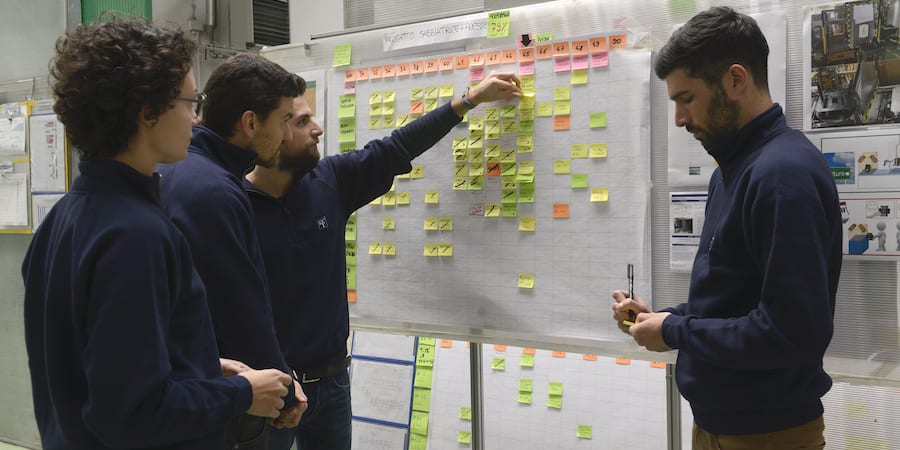
A3 problem solving to develop Ohio’s school leaders
INTERVIEW – A program that aims to help disadvantaged school districts in Ohio used A3 thinking to teach principals how to scientifically solve problems together with their teachers. We met a principal and one of her teachers.
Interviewees: Peg Pennington, Executive Director of Center for Operational Excellence at Ohio State University; and Aneesa Locke-Hines, Social Service Progran Manager, State of Ohio - Opportunities for Ohioans with Disabilities
Roberto Priolo: Can you introduce the BRIGHT Program to Planet Lean readers, please, and explain in what way lean fits into the picture?
Peg Pennington: The BRIGHT MBA Program started last year. It was an idea generated by the Ohio Business Roundtable in collaboration with the Ohio Department of Education and the Fisher College of Business at the Ohio State University. It aims to help school children in disadvantaged districts.
The program is directed at professionals from outside the education system (like government, the military or business), who are given a placement in school districts across the state of Ohio for a year while earning an MBA.
I was asked to teach the Operations portion of the curriculum, and it is within that context that I decided to give students A3 thinking. I wanted them to learn how to think critically through problems. Each participant in the program created an A3 on the projects they had worked on with the teachers of the school they were working at throughout the academic year, and I then coached them on those A3s.
RP: Aneesa, can you tell us about your background and how you got to take part in the BRIGHT program?
Aneesa Locke-Hines: My background is largely in social services. For the past 10 years I have worked at Opportunities for Ohioans with Disabilities (OOD), the State of Ohio agency that strives to secure quality employment and independence for Ohioans with disabilities. I have a 16-year-old son living with a disability, who really struggled in school. This, coupled with my passion for education, made the BRIGHT program particularly appealing to me.
RP: What was your favorite thing about the program? What was the biggest lesson it taught you?
ALH: The program was transformational. It gave me two new perspectives: the placement as principal of a school allowed me to look at the state of our education system from the inside (after being a parent advocate on the outside for many years), while the MBA taught me how leadership needs to behave if change really is to come about. Looking back, the two fit together perfectly and provided me with a very strong foundation. It was exhausting, but truly great.
The biggest lesson I learned was about leadership. The program taught me that ultimately leadership is about finding out what is great about your people and bringing it out. No one can do it alone. Instead, a leader has to learn to maximize her resources – people being the most precious of them all. Coming from social service, I already shared that view, but going through the MBA really echoed that and made me feel more comfortable as a leader.
RP: Back to you, Peg. What did you specifically focus on while teaching the students about A3 thinking?
PP: The problem was that they didn’t have clear metrics to work on – a common situation in every type of organization. We had to break the cycle of fixing something without knowing what the gap was: A3 thinking helped the principals to go back to the very beginning to really understand the current state and describe it in the form of a metric. In manufacturing looking at trends is something we mostly take for granted, but in education this is new.
I spent a lot of time on the cause-and-effect diagram we see in John Shook’s Managing to Learn. If there’s a gap in a school’s reading score, for example, there is a multitude of issues that can be related to that. I got the MBA students to recognize that teachers have to be part of the solution and work together to fix problems. To improve and create change, you need to have the teachers on board.
A3 thinking helped the students see issues within a systemic context. While some of the problems the children face are too big for us to solve on our own, understanding the context is important for us to deliver on what we can influence.
RP: Can you give me an example?
PP: Sure. There is a protocol for how teachers are supposed to break up a fight: they normally send the children involved to the principal’s office. When they do that, however, the children are out of class for around 55 minutes, which has a detrimental effect on their reading and math scores down the road. Once the big picture is analyzed, it becomes clear that what seems like a normal reaction can in fact have a very negative impact later on. If, as a teacher, I see a bad interaction between students, how do I back that down? What can I do to get class to proceed as normal without sending the child to the principal’s office? It may seem like a small thing, but it actually was a big cause of variation in the schools we looked at.
RP: How did the MBA students react to A3s and what results you think you have achieved?
PP: Some of them got it right away, especially those with an industrial background. I remember one of the MBA students immediately getting into it and using the cause-effect diagram to ask teachers to understand why certain problems were occurring (rather than think he was blaming them for it). They then mapped the situation together.
What I have tried to do (and I believe I have succeeded in that) is teach the MBA students a different way of thinking. First of all, showing them – as Aneesa said – that they can’t go at it alone. Secondly, by helping to understand the difference between success and failure: what method are we using to test and learn whether a certain change has had the desired effect?
RP: What did you think of the A3 exercise, Aneesa?
ALH: Once it all came together and we had a finished A3, I realized how amazing it was. Looking at the data and going from process to process removes the emotion from the equation and helps you to look at the problem objectively. Discussing with teachers the reasons why our kids are not performing well can make for a rather emotional conversation, but when you are looking at it in the form of data it becomes easier to deal with: given the information we have, here’s how we can behave.
To reach this point I had to work on eliminating my own personal bias, which were leading me down a specific path. Peg’s coaching helped me to understand why I was jumping to a solution I thought was right rather than the one the data showed to be the most logical. There is no doubt the hardest part is stepping back and understanding where you feel like going versus where the data is taking you. Right now, I am using A3 thinking on a regular basis: it helps me not to get buried in the problem at hand and to really go about finding a solution for it.
RP: Peg, another one for you. What opportunities do you see for programs like BRIGHT in the United States?
PP: Every organization in America and beyond can benefit from really understanding the point of concern they are trying to solve, rather than simply lay out solution after solution. The BRIGHT MBA program is a proposed countermeasure to traditional methods – a way to study whether or not what we are doing in education is effective. Applying the scientific method (and A3 is all about that) makes you a critical thinker… we need more of that!
RP: What about you, Aneesa? What do you think about the potential of these types of programs?
ALH: Every decision that we make has to be around the kids! It sounds elementary, but it’s often not how we see things. There is a lot of clutter in the system right now and a lot of stuff that needs to be improved. If anyone is ever brave enough to step back and ask whether all of this that we are doing actually helps us to meet our primary goal – our students’ education – we will see progress skyrocket. I think the first step towards it is to get rid of all the clutter and focus on what’s important in our education system.
In my next role, as principal of the worst performing school in my city, I want to make a different for kids. I don’t want them to struggle like my son did to earn an education.
THE INTERVIEWEES


Read more


INTERVIEW - We caught up with LEI’s Senior Advisor, Jim Morgan after his plenary talk at the Lean Summit in São Paulo last month and got him to answer a few questions about product development and lean management.


RESEARCH – Every advocate of lean with a skeptical boss has been asked “What’s the ROI of lean?” at least once. This landmark article explains that lean can indeed help us to achieve a superior ROI, so long as we view it as an all-encompassing strategy rather than a simple tactic.


INTERVIEW – At the European Lean Summit in Venice, our editor sat down with Italy’s lean CEO extraordinaire. His company, which serves the natural gas industry, has been on the journey for almost two decades.



INTERVIEW – At the recent European Lean Summit, we sat down with a senior executive from Fiat Chrysler Automobiles to learn more about the company’s World Class Manufacturing approach.

